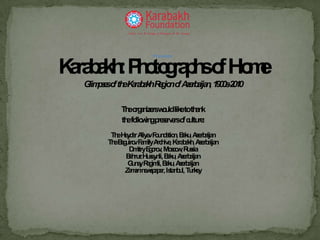This document provides information about the Karabakh region of Azerbaijan through a calendar titled "Karabakh: Photographs of Home". It includes photographs and descriptions of historical and cultural sites from Karabakh from 1900-2010. The introduction thanks organizations that helped preserve Azerbaijani culture. The document then provides background information on the location, origins of the name, ancient history as part of Caucasian Albania, and centuries of rule under different empires of Karabakh. It displays photographs of historical sites like the Shusha Castle wall, mosques, streets and homes of Shusha, and famous cultural figures from the region. The calendar aims to showcase the culture and heritage of Karabakh for Azerbaijanis worldwide.
































![Literature and Music in Azerbaijan
Azerbaijan preserves a centuries-old legacy of reverence for all of its great musicians, writers, poets, and intellectuals,
many of whom have hailed from Karabakh. ―The people of Azerbaijan have retained their ancient musical tradition.
For example, the art of ashugs, who improvise songs to their own on an instrument called a kobuz, remains extremely
popular. Mug[h]ams, vocal and instrumental compositions, are also widely known, the town of Shusha being
particularly renowned for this art.‖ (Source: Azerbaijan: Cultural Life, Encyclopædia Britannica.)](https://image.slidesharecdn.com/karabakhslideshow1-130729110124-phpapp02/85/Karabakhslideshow-1-33-320.jpg)





![Karabakh Endures . . .
Over the centuries, Karabakh has endured many sieges and acts of occupation yet has emerged as a center of
Azerbaijani culture beloved by Azerbaijanis around the world. These are our mountains and this is our heritage.
From a reported exchange during the 1795 Siege of Shusha, then capital of the Karabakh khanate
"Lunatic! A hail of stones descend from the catapult of heavens, while you await wonders in walls of glass?"
– Message transmitted via bow and arrow to the town of Shusha by Aga Muhammad shah Qajar,
Azerbaijani-Turkic ruler of the Iranian Empire, written by his court poet Urfi
"If my protector is the one that I know, [he] would protect the glass along side the most solid stone.”
– Response sent back by Ibrahim-Khalil khan Javanshir, the ruler of the Karabakh khanate,
written by his vizier, the renowned poet Mollah Panah Vagif (1717-1797)](https://image.slidesharecdn.com/karabakhslideshow1-130729110124-phpapp02/85/Karabakhslideshow-1-39-320.jpg)

